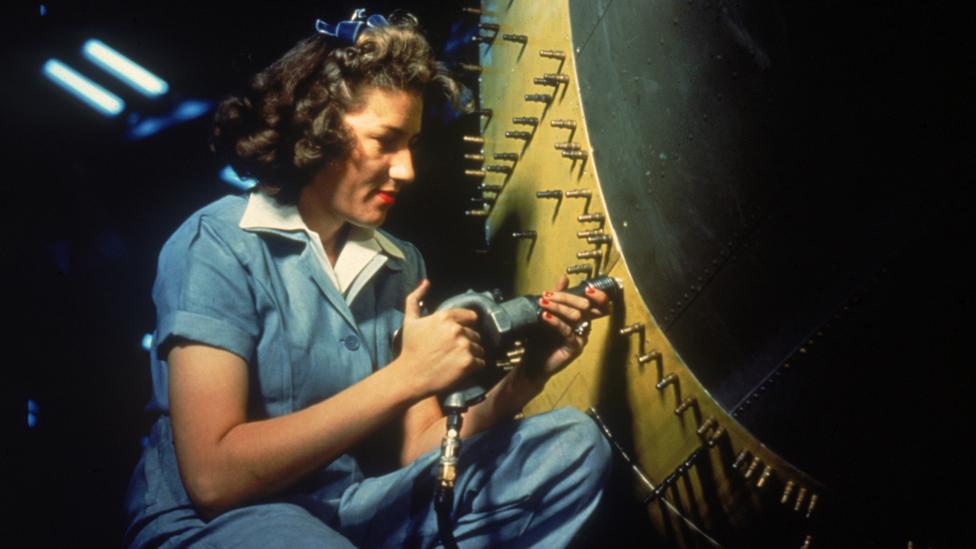
By Adrienne Bernhard 30th April 2020
https://www.bbc.com/future/article/20200430-covid-19-what-we-can-learn-from-wartime-efforts
Language more normally suited to wartime is commonly invoked around the Covid-19 pandemic, but can we learn anything from past conflicts in our battle against coronavirus?
In January 1941, Winston Churchill gave a sombre address to the House of Commons, the UK’s parliament. “Our Empire and indeed the whole English-speaking world are passing through a dark and deadly valley,” he remarked in one of World War Two’s bleakest periods. “But I should be failing in my duty if, on the other wise, I were not to convey the true impression, that a great nation is getting into its war stride.”
Comparisons between World War Two and the current coronavirus pandemic are prolific. New York Governor Andrew Cuomo, who has been compared to a wartime president, has peppered his daily briefings with combative language, describing the apex of the disease’s curve as “the next battle at the top of the mountain”, and proclaiming “ventilators are to this war what bombs were to World War Two”.
European leaders, meanwhile, talk of an inevitable “D-Day” when the outbreak will overwhelm the hospital system, and allude to war with an invisible enemy. Healthcare workers are on the frontlines, scientists are the new generals, economists draw up battle plans, politicians call for mobilisation. Just a few weeks ago, Queen Elizabeth II urged Britons to adopt the same discipline and resolve that the people had showed during WWII. “It reminds me of the very first broadcast I made in 1940, helped by my sister,” the monarch recalled during a rare televised address.
The coronavirus pandemic, though different from the war in many crucial respects, seems to demand some of the same measures used during that global emergency. From boosted production to rapid redeployment of resources, increased governmental oversight and stimulus plans to potential rationing, 2020’s battle against a virus might force great nations to once again adopt their war strides.
Are there lessons we can learn from the collective anxiety, the contingency measures, the calls for national cohesion and the dramatic changes to society that defined WWII? Is there is a fallacy in the modern conception of the immediate “united front” – a fallacy that will continue to play out against the backdrop of the pandemic? What does shared sacrifice look like, and how will it shape our future this time around?
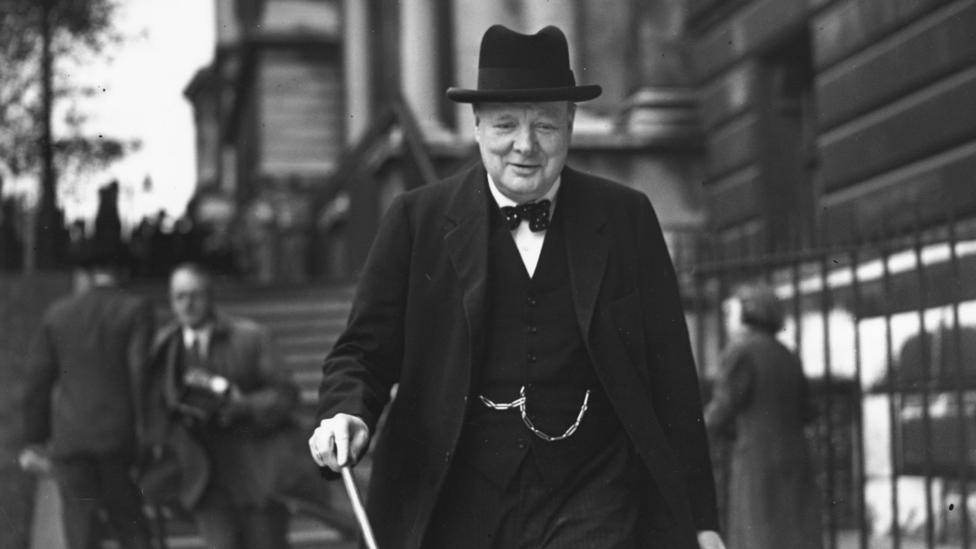
The spirit of Britain's wartime leader Winston Churchill is often invoked by those urging the adoption of measures against coronavirus (Credit: Getty Images)
The extent to which wartime psychology is relevant to our understanding of the coronavirus pandemic is, like the trajectory of the disease itself, unclear and rapidly evolving. When politicians (or journalists) reach for convenient parallels between the pandemic and those wartime battles, they may make dangerous assumptions. Comparisons that rely on militarisation, organised violence or the threat of civilian control aren’t useful, and can even be harmful, especially as new information becomes available and data changes by the hour.
“If we mount a war on coronavirus, that doesn’t solve fundamental problems in the healthcare system or in global trade, for example,” says Mark R Wilson, professor of history at the University of North Carolina. “We constrain our imagination by thinking about a short-run war mobilisation.” Insidious global problems such as equipment shortages, health care disparities, lack of emergency protocols, confusion between federal and local policies, poverty and societal inequity can’t be neatly addressed by a rapid offensive against Covid-19, even if that battle is metaphoric. “There is no automatic formula for what happens during and after a crisis,” Wilson adds. “But right now, people can and should still take an interest in the past.”
Neurosurgeons, cardiologists, medical students– all have been pulled into emergency rooms and intensive care wards
During World War Two, a dire need to radically accelerate the output of items such as ships, tanks and bombers led to a mobilised wartime economy. The United States and Great Britain, in particular, converted existing factories that once made civilian products into those that could produce military equipment. Car manufacturers built army trucks instead; clock companies and plumbing industrialists designed ammunition cartridges; silk stockings were repurposed for parachutes.
Over the past month we’ve once again seen this phenomenon of conversion, as companies across the globe repurpose production lines in an effort to turn the tide of the outbreak. In just 72 hours, luxury brand Louis Vuitton began manufacturing hand sanitiser with alcohol normally used in its perfume distillery, which it then distributed to hospitals across France. General Motors, the US auto manufacturer that mass-produced tanks in World War Two, has pivoted once again, this time producing thousands of ventilators, while clothing retailers in the UK have turned from fashion to manufacturing in-demand surgical N-95 masks.
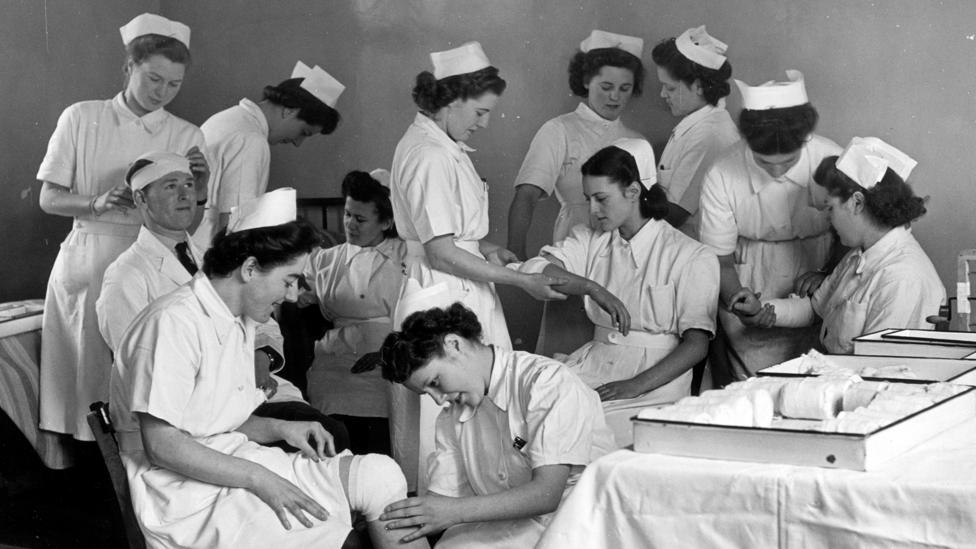
The war also spurred massive social changes, such as the development of universal health care in countries including the UK (Credit: Getty Images)
Airlines across the globe have begun chartered flights to repatriate stranded nationals abroad and transport health care workers and medical supplies to deeply impacted regions. Hospital ships such as the USNS Comfort, designed to treat casualties of war, now offer a relief valve for hospitals overwhelmed with Covid-19 patients.
This redeployment calculus applies not just to goods and services but to human capital as well. Neurosurgeons, cardiologists, medical student – all have been pulled into emergency rooms and intensive care wards. Receptionists who normally deal with billing are suddenly tasked with screening coronavirus patients, making up for an acute shortage of personnel. Restaurant workers prepare and deliver meals in bulk to exhausted emergency care nurses, parents have become full-time teachers to their children, hotel managers are being trained in hospital protocol as they open their doors to health care workers.
During World War Two, the measures used to ramp up production took months to implement; today, it would appear that we had not months, but weeks. And our current efforts seem patchwork at best. World War Two’s unprecedented mobilisation effort, by contrast – its dramatic output, profit control and federal regulation – might serve as a blueprint during the next phase of the coronavirus outbreak. As they did during the war, officials could opt to fund brand new factories and equip them with machinery and tools (in this case, ventilators or personal protective gear).
The short-term financial cost of these measures would be enormous, but the payoff could be too
By establishing dedicated Covid-19 facilities rather than converting existing ones, governments would expand capacity and absorb risk. Over the next several months, these factories could implement production lines to speed the creation of antibody tests and a vaccine. And authorities could further regulate the crisis standard of care – allocating treatment to certain patients – and ration medical equipment or even food.
The short-term financial cost of these measures would be enormous, but the payoff could be too. Indeed, rapid government intervention in the months following the coronavirus outbreak has already shown signs of success. In China, for example, thousands of workers built a field hospital on government orders; modular construction and rapid mobilisation meant that thousands more Covid-19 patients could be treated in a matter of days.
Federally mandated social distancing has also worked to compress the timeline – a kind of individual sacrifice reminiscent of wartime strain on the home front. World War Two’s iconic message of “equality of sacrifice,” emphasised by labour leaders and union officials and propagated through steep progressive taxes and government regulations, would be hard to sustain in today’s political and financial landscape. But in recent weeks, people have shown a desire to comply, even to make personal sacrifices for the greater good.
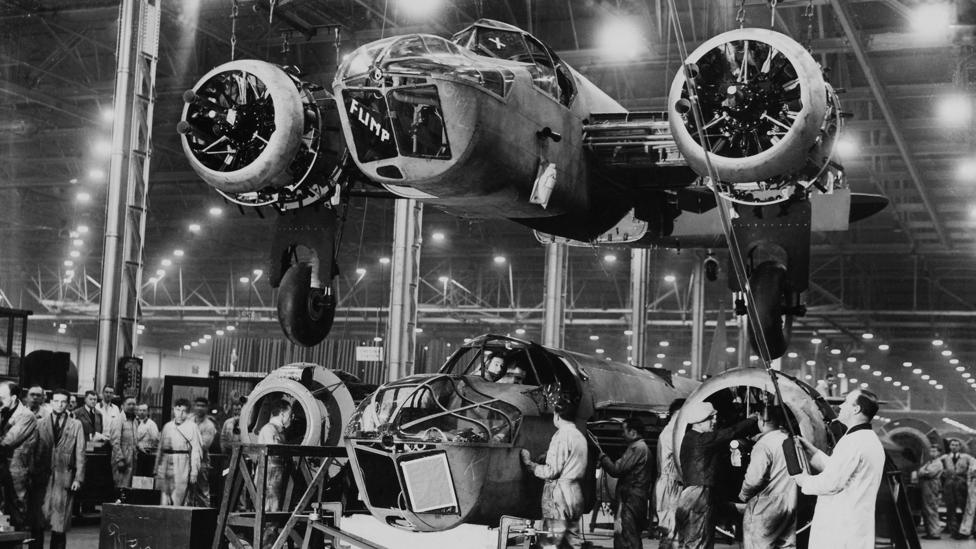
During World War Two, factories which had once made cars were quickly reorganised to make weapons such as these British bombers (Credit: Getty Images)
“People are turning to war as a metaphor because of the mobilising aspects of war,” says Mary L Dudziak, a law professor at Emory University who has published widely on the concept of wartime in US history. “But a pandemic is not a ‘war’. A country responds to war by killing other people: death is the means of war. In a pandemic, the means of responding is not killing other people but instead trying to preserve life.”
The desire to comply, to make personal sacrifices, these are no longer for the purpose of destruction, but for a greater good that is truly good: mutual assistance across nations and the safeguarding of human life
“Moments of crisis can provide opportunities for reform,” says Wilson. World War Two brought national healthcare reforms, gave rise to international organisations like the United Nations and the International Monetary Fund, and in the US led to the introduction of the GI Bill, which detailed important benefits for soldiers returning from war.
There will be no “return to normalcy” after the coronavirus pandemic
Of course, not all reforms at the time were sweeping in scope. While the UK’s universal health care system, the National Health Service (NHS), emerged out of World War Two, the US ended up with a far less robust system; many were left uninsured. The coronavirus crisis might bring about similar reforms; for example, targeted compensation packages for health care workers or grocery store staff. Or it might engender an entirely restructured economy, resulting in universal health care or increased job security. At the very least, we can expect to see a new generation of political leaders and thinkers to come out of it.
Consider the scientific experts now on the front lines. Just as generals take the lead in giving daily briefings in wartime, medical experts like Anthony Fauci are at the microphone to explain complex ideas like epidemic curves, social distancing and off-label use of drugs. Healthcare professionals are perhaps the new wartime generals.
After World War Two, much of Europe and Asia lay in ruins. The figures are difficult to grasp – nearly 60 million dead. Indeed, 1945 has often been referred to as Year Zero: a new way to mark time before and after the war’s destruction. People the world over confronted a landscape that had been changed forever, marked by deprivation but also by hope. Government expenditures helped bring about the business recovery that had eluded President Roosevelt’s New Deal .
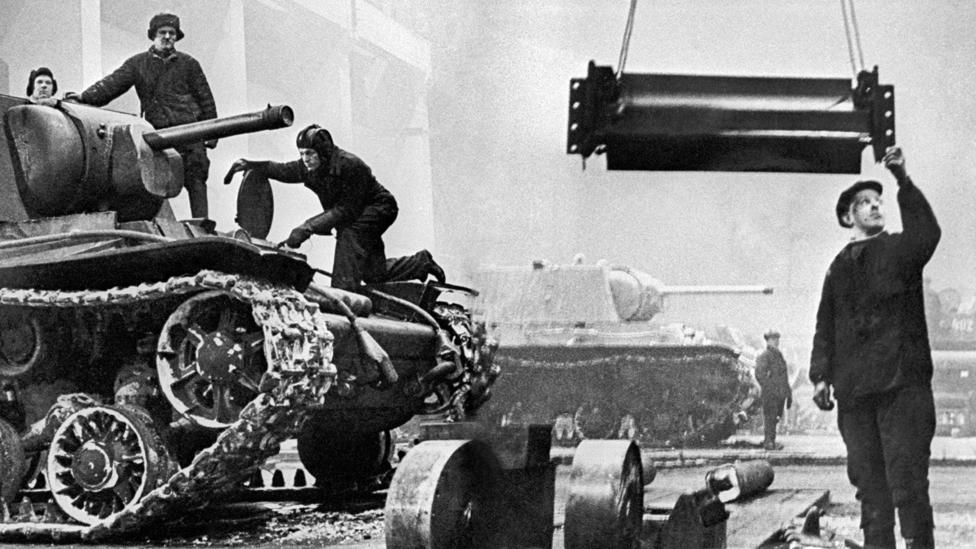
While the industrial conversion hasn't been as dramatic as turning tractor factories into tank plants, it has been widespread and rapid (Credit: Getty Images)
Throughout the US and Europe, wartime mobilisation and ingenuity secured employment and a fairer distribution of income, while creating entirely new technologies, industries and associated human skills. Old ideological constraints collapsed, but new ideas about capital, entrepreneurship, and social bonds emerged. These extraordinarily ambitious efforts – civilian and federal, at home and abroad – meant that nations could ultimately recover.
To misquote a post-war US presidential candidate, there will be no “return to normalcy” after the coronavirus pandemic. From the comfort of our homes, we may sit and leaf through the pages of history, imagining various after-lesson actions – but we know for certain only that nothing can be certain.
Yet, this crisis has arguably spurred mobilisation on an international scale not seen since the war 80 years ago. The pandemic demands quick crash efforts with high stakes, has united people across the world, and promises to accelerate seismic global changes which could last for years to come.
Then, as now, we might take some courage in the Queen’s wartime vow: “We will be with our friends again. We will be with our families again. We will meet again.”







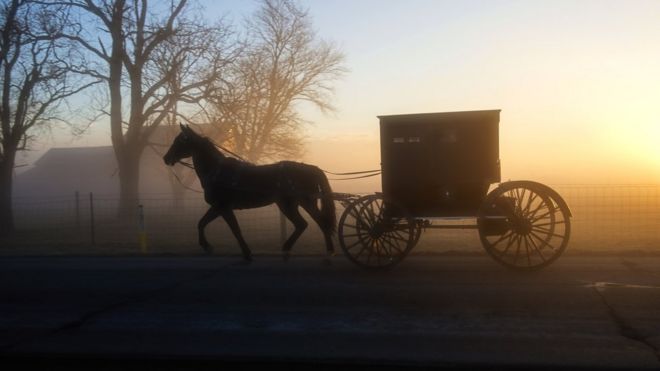

/https://public-media.si-cdn.com/filer/ef/b0/efb0a152-6e68-4777-b148-a78747464260/babe-ruth-social-media-dimensions.jpg)

/https://public-media.si-cdn.com/filer/f0/06/f0066459-8cd6-486a-ac4d-e3491bb593a3/gettyimages-96357907.jpg)
/https://public-media.si-cdn.com/filer/6f/fc/6ffcea0f-ea5a-445b-b683-e584bdbd0227/gettyimages-549921185.jpg)
/https://public-media.si-cdn.com/filer/ca/65/ca6548ad-cd01-4175-a609-60b51438e3c9/gettyimages-530858858.jpg)
:focal(1939x998:1940x999)/https://public-media.si-cdn.com/filer/0f/a5/0fa5489c-dc4e-495d-a55a-f9854f3ada53/ludington_wreckage_1.jpg)
/https://public-media.si-cdn.com/filer/ac/8a/ac8a1886-28af-4a93-b854-5c7e3b2421b7/ludington_wreckage_3.jpg)